► Limited-run coachbuilt coupe previews EV design
► 730bhp Batur is most powerful ICE Bentley ever
► All are spoken for, with first deliveries 2023
Bentley has begun testing its new Batur coupe ahead of its mid-2023 launch. Just 18 examples will be produced, but the design itself still needs to undergo durability tests for sunlight stimulation, high speed stability, aerodynamics, road handling and more. The Batur’s W12 engine will also need to be tested in its new environment too.
Batur #0, Crewe’s test car will first undergo a 2500km drive across Europe, before heading to proving grounds for further high-speed testing work. After that, there’ll be another 7500km of real-world driving accounting to 600 hours of overall testing.
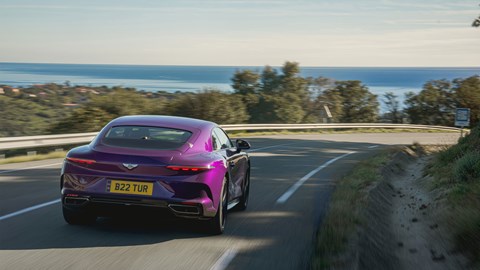
‘There are a number of unique features that bring new challenges. For example, the exterior headlamps are very compact LED units and made to our styling teams challenging proportions, which transforms the exterior appearance of the car but are complex to produce,’ said Paul Williams, chief technical officer for Mulliner. ‘We’re also working with the most powerful development of the W12 in its 20-year history, which brings an enormous validation programme.
‘And even though there will only be 18 Baturs produced, the level of quality has to be identical to every one of the 15,000 cars Bentley is currently producing each year.’
Bentley Batur: what you need to know
The Batur’s an intriguing machine, and one with significance beyond its 18-unit production run and £1.65m (excluding taxes) pricetag. Yes, 18 cars still isn’t very many. But that represents a 50% increase in volume over the convertible Bacalar, the first Mulliner coachbuilt car – an indicator of Crewe’s increasing confidence as it exploits its ability to craft bespoke cars for its most discerning clients.
And while the Batur is resolutely combustion-engined, it previews the design direction of Bentley’s electric age. There’s been a changing of the guard at Bentley design, and the Batur is new director of design Andreas Mindt’s statement of intent.
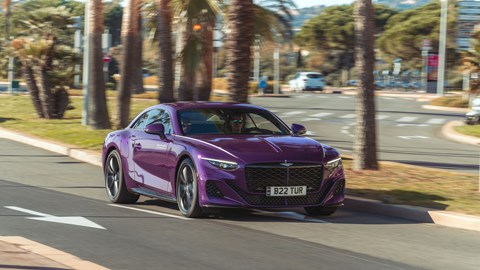
Those battery-electric Bentleys (well underway, at the clay model stage, and all Mindt’s work) are crucial to safeguarding Bentley’s future, and the Batur gives us a sneak peek at the cars Bentley’s £2.5 billion electric investment will yield.
The best electric cars on sale today
The 2023 Bentley Mulliner Batur: your essential lowdown
Bentley describes the Batur as a two-door grand touring coupe. So, a lot like a future Continental GT, then. All 18 cars are spoken for, and the lucky few get most-powerful-Bentley-to-date bragging rights thanks to a revised W12 with new turbos, intercoolers and intake system.
The result is 730bhp and 738lb ft of torque, with CEO Adrian Hallmark admitting that the engine, which only has a few years left to live (Bentley will launch five EVs in five years from 2025, before dropping the last of its combustion engines by 2030) is nearing its reasonable limit.
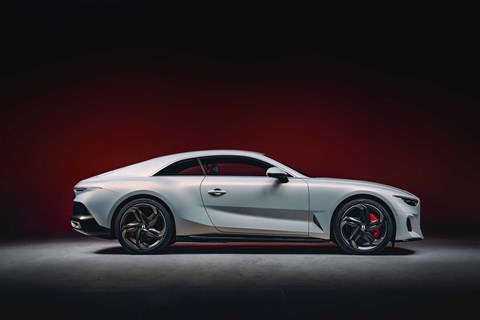
Under the skin the Batur wears much of the go-faster powertrain and chassis kit developed for the flagship Continental GT Speed. So that’s three-chamber air suspension, 48-volt anti-roll control, four-wheel steering and the Speed’s slick electronic limited-slip differential. 22-inch wheels and carbon-ceramic brakes complete the chassis specification. The exhaust system is titanium, and its end pieces 3D printed in the stuff.
Doesn’t sound all that radical…
Indeed not. We’ve driven both the Continental GT Speed and the Bacalar, and the Batur promises nothing less than more of the same: outstanding any-rev drive courtesy of that Peterbilt-esque torque, and far more agility and poise than cars this heavy should, by rights, be capable of summoning.
But the exterior design is pretty radical – by Bentley’s modest rate of change, at least. For a start the face is new, and slips the leash that has kept Bentley headlights vaguely circular – a nod to the iconic lamps of cars like the Blower – for as long as anyone can remember.
Expect cleaner, less busy designs, too. CEO Adrian Hallmark: ‘When you look at the Batur, you see we can achieve a lot of power and strength in the design without having three lines on every panel. We want to get away from that; to calm things down and focus on proportions.’
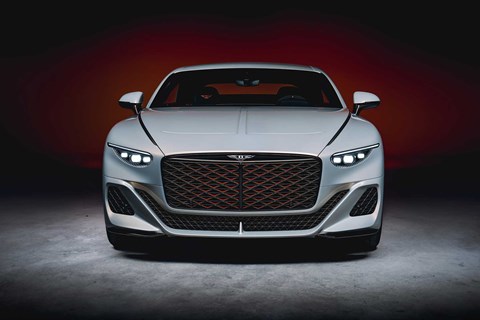
‘The headlight design is very important for Bentley,’ says Mindt, who joined Bentley from Audi, where he penned the stunning e-Tron GT. ‘I wanted something more focused on the future, more progressive. Linked to the new headlights is the very upright front of the car, which gives it more visual strength. This should be upright, not leaning backwards – not looking up into the sky like we did in the past.’
Proportionally the Batur’s undoubtedly strong, with a long bonnet and fast roofline. ‘The silhouette is really nice; very Bentley,’ explains Mindt. ‘It has this really strong C-pillar, which is crucial for us, and what we’re calling our ‘endless’ bonnet. There is a line that stretches from the bonnet along the whole length of the car and making the car look long and lean. The visual mass of the car is moved rearwards, giving the impression that the car is sat on the rear axle. We had in mind the very beautiful Continental R-Type when we did this.’
Like Range Rover and Rolls-Royce, Bentley design is also evolving to be a little less ostentatious. You won’t find whiskey-tumbler lights on the Batur, nor Mindt’s future Bentleys, and the surfaces are simpler. The same applies inside.
While the Batur’s interior betrays its current-gen Continental GT underpinnings (albeit with 3D-printed gold adornments, if that’s your thing), Mindt is keen to reduce the clutter, tread a sensible line between digital and analogue interfaces, and to focus on the good stuff; sumptuous materials and the peace and quiet a good Bentley does so well.
‘We are reducing decoration on the outside, and it’s absolutely the same thing inside. But we don’t want our cars to be like an empty bathtub inside. What is important for a Bentley interior is that it’s a cossetting haven. It should feel like you’re being embraced, and that you feel safe in there.
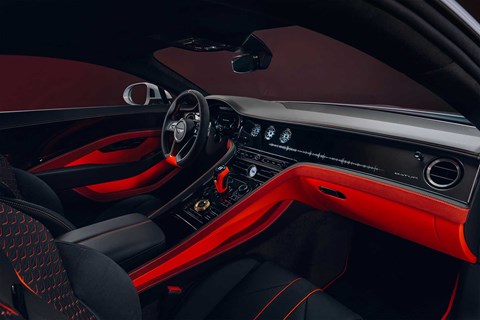
‘And with our interfaces we will bring the digital and the analogue together in a really beautiful way. Lots of brands are all digital – they have banned knobs and buttons. We don’t say that. We want to bring these apparently contradictory things together, and to dial up the user interface experience.’
Do we know any more about Bentley’s first electric cars?
We know they won’t compromise design in the name of low drag. CEO Hallmark: ‘We’ve always said we’ll go battery-electric around the middle of the decade. When you get to 115-plus kilowatt-hour power density in the car, then we can function on parity with a regular Bentley in terms of distance travelled on a charge. Aero is going to be increasingly important but it doesn’t mean we all have to make cars that are the same shape. And we’ll trade a bit of efficiency and range for something that looks better, especially in the luxury sector.’
Bentley’s electric plans explained
Bentley will also look to exploit the flexibility of EV platforms as it expands its bespoke offering and looks to head back to the area of the market it left when it retired the Mulsanne – namely the bit beyond £300,000.
‘In the past we had Mulsanne up to £350,000,’ explains Hallmark. ‘At the top, we don’t have a regular £350,000 car at the moment. Part of the reason for doing coachbuilt cars is to create the headroom and the customer base to sell £350-£500,000 cars. Not because we’ll take our current cars and lift the prices, but because we’ll create bigger runs of limited-run, higher-price cars that aren’t mainstream models. That’s where we’re going with electric architectures. The new manufacturing investment strategies will be far more flexible at a lot lower investment costs per module than has been in the case in the past.’